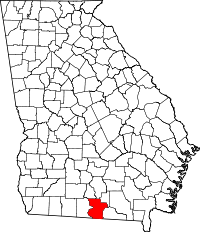Valdosta, Georgia
| Valdosta, Georgia | ||
|---|---|---|
| City | ||
 Valdosta City Hall | ||
| ||
| Nickname(s): Azalea City, Sportstown, Titletown USA, Winnersville | ||
| Motto(s): "A City Without Limits" (2002-Present)[1] | ||
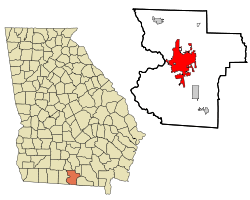 Location in Lowndes County and the state of Georgia | ||
| Coordinates: 30°50′48″N 83°16′59″W / 30.84667°N 83.28306°WCoordinates: 30°50′48″N 83°16′59″W / 30.84667°N 83.28306°W | ||
| Country | United States | |
| State | Georgia | |
| County | Lowndes | |
| Incorporated | December 7, 1860 | |
| Government | ||
| • Mayor | John Gayle | |
| Area | ||
| • City | 30.3 sq mi (78.4 km2) | |
| • Land | 29.9 sq mi (77.5 km2) | |
| • Water | 0.4 sq mi (0.9 km2) | |
| Elevation | 220 ft (67 m) | |
| Population (2010) | ||
| • City | 54,518 | |
| • Estimate (2016)[2] | 56,474 | |
| • Density | 1,801/sq mi (695.4/km2) | |
| • Metro | 139,588 | |
| Time zone | UTC−5 (EST) | |
| • Summer (DST) | UTC−4 (EDT) | |
| ZIP codes | 31601-31606, 31698 | |
| Area code(s) | 229 | |
| FIPS code | 13-78800[3] | |
| GNIS feature ID | 0324649[4] | |
| Website | City of Valdosta Website | |
Valdosta is a city in and the county seat of Lowndes County, located on the southern border of Georgia, United States. As of 2013, Valdosta has a total population of 56,481,[5] and is the 14th largest city in Georgia.[6]
Valdosta is the principal city of the Valdosta Metropolitan Statistical Area, which in 2010 had a population of 139,588.[7] It includes part of Brooks County to the west.
Valdosta is the home of Valdosta State University, a regional university in the University System of Georgia with over 10,900 students.[8] The local public Valdosta High School has the most winning football program of any high school in the United States.[9]
Valdosta is called the Azalea City, as the plant grows in profusion there. The city hosts an annual Azalea Festival in March.
History
Establishment
Valdosta was incorporated on December 7, 1860, when it was designated by the state legislature as the new county seat, formerly at nearby Troupville. The railroad was built to Valdosta that year, rather than Troupville, stimulating development in the new county seat.[10] Many citizens of Troupville had already relocated to Valdosta when the Atlantic and Gulf Railroad was built four miles (about 6 km) away. On July 4, 1860, the engine known as Satilla No. 3 pulled the first train into Valdosta on the Atlantic and Gulf Railroad.
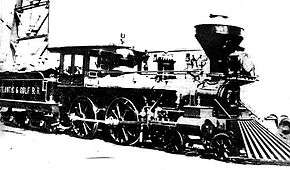
Valdosta is located in the coastal plain of Georgia and has a virtually flat landscape. It was once the center of long-staple cotton growing in the United States, a lucrative crop both before and after the Civil War. The county had a majority-white population well before the war with a substantial black population, as the cotton plantations were dependent on masses of enslaved field laborers.
The sixty miles (97 km) of railway between Valdosta and Waycross were once the longest straight stretch of railroad in the world.[11] Today highways stretch through the county for miles with hardly a curve, rise, or fall.
After being bypassed by the railroad and losing the county seat, Troupville was virtually abandoned. It had been named after Governor George Troup, for whom Troup County, Georgia, was also named. Valdosta was named after Troup's plantation, Valdosta (occasionally the Val d'Osta spelling was used for the plantation). Troup had named it after the Valle d'Aosta in Italy. The name Aosta (Latin: Augusta), refers to Emperor Augustus. A long-standing rumor held that the city's name meant "vale of beauty."[12]
1861 to 1899
The American Civil War erupted just months after the establishment of Valdosta. During the war, Valdosta was far away from battles and became a refuge for those fleeing areas of Georgia where the war was being activelly fought.
After the American Civil War, during the Reconstruction era more than 100 freedmen, families of farmers, craftsmen, and laborers, emigrated from Lowndes County to Arithington, Liberia, in 1871 and 1872, looking for a better life. Since before the war, the American Colonization Society had supported the relocation of free blacks to Liberia, an American colony in West Africa established for this purpose. The first group from Lowndes County left in 1871, and were led by Jefferson Bracewell; the second group was led in 1872 by Aaron Miller.[13] Many freedmen ended up working as sharecroppers and tenant farmers on area plantations in Lowndes County, as cotton agriculture continued well into the 20th century.
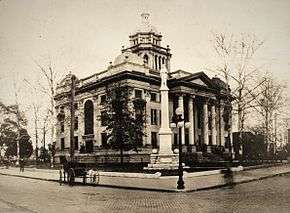
One notable event during Reconstruction was at a political meeting in front of the courthouse. A carpetbagger named J. W. Clift was running for Congress and was looking for support from former slaves. During Clift's speech he also verbally attacked whites of Valdosta. In response five men planted explosives at the courthouse planning on setting them off at Clift's next political rally. When other whites arrived at the courthouse unaware of the explosives the five men decided to stop the explosives but some still managed to go off. The explosion was small and no injuries occurred. The five men were arrested and were going to go on trial but Union soldiers took them to Savannah for trial. The Union soldiers taking the five men was seen as an overreach of authority and an endangerment for self-government.[14]
As mechanization was introduced, the number of agricultural jobs decreased and Valdosta became more industrialized by the 20th century. The world's second Coca-Cola bottling plant began bottling Coca-Cola in Valdosta in 1897.[15][16] In 1899, the cotton mill town of Remerton was established. When it was established, Remerton was 2 miles (3.2 km) from the town of Valdosta. It has since become an enclave of Valdosta due to the growth of Valdosta.
1900 to 1939

A new courthouse was planned in 1900 to replace the smaller courthouse. Construction began in 1904 for around $75,000. The old courthouse was torn down in March 1904. The new courthouse was completed in 1904 and on April 14, 1905 the first session of court took place in the new courthouse.[17]
In November 1902, the Harris Nickel-Plate Circus' prize elephant, Gypsy, went on a rampage and killed her trainer James O'Rourke. After terrorizing the town for a couple of hours, she ran off to Cherry Creek, north of Valdosta. Gypsy was chased by Police Chief Calvin Dampier and a posse. Gypsy was shot and killed and buried on site. James O'Rourke was buried in Sunset Hill Cemetery in Valdosta.[18][19]
On July 28, 1907, Valdosta voted to become a dry city; a record $10,000 worth of whiskey was sold on the last day. The city had been wet since its founding.[20]
In 1910, cotton was still important to the economy and Fortune magazine ranked Valdosta as the richest city in America by per capita income.[21] Soon after that, the boll weevil invaded the South, moving east through the states and killing much of the cotton crop in this area in 1917. Agriculture in this area turned to tobacco and pine timber. In January 1913, the South Georgia State Normal College opened in Valdosta on the edge of town. Over the course of the following century, it evolved into Valdosta State University. The school gradually became a regional center of higher education that has drawn many to the city.
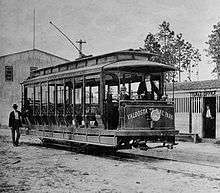
On May 16, 1918 a white planter named Hampton Smith was shot and killed at his house near Morven, Georgia by a black farm worker named Sidney Johnson who was routinely mistreated by Smith. Johnson also shot Smith's wife but she later recovered. Johnson hid for several days in Valdosta without discovery.[22][22] Lynch mobs formed in Valdosta ransacking Lowndes and Brooks counties for a week looking for Johnson and his alleged accomplices. These mobs lynched at least 13 African Americans among them Mary Turner and her unborn eight-month-old baby whom was cut from her body and murdered. Mary Turner's husband Hazel Turner was also lynched the day before.[22]
Sidney Johnson was turned in by an acquaintance and on May 22 Police Chief Calvin Dampier led a shoot out at the Valdosta house where he was hiding. Following his death, a crowd of more than 700 castrated Johnson's body, then dragged it behind a vehicle down Patterson Street and all the way to Morven, Georgia, near the site of Smith's murder. There the body of Johnson was hanged and burned on a tree. That afternoon, Governor Hugh Dorsey ordered the state militia to be dispatched to Valdosta to halt the lynch mobs, but they arrived too late for many victims. Dorsey later denounced the lynchings, but none of the participants was ever prosecuted.[22]
Following the violence, more than 500 African Americans fled from Lowndes and Brooks counties to escape such oppressive conditions and violence. From 1880 to 1930, Brooks County had the highest number of lynchings in the state of Georgia.[22] By 1922 local chapters of the Ku Klux Klan, which had been revived starting in 1915, were holding rallies openly in Valdosta.[23]
1940 to present
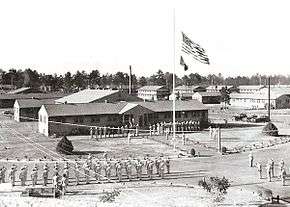
On June 26, 1941 Moody Army Airfield opened 10 miles (16 km) to north-east of the town as part of the United States' preparation for the country's potential involvement in World War II. Moody Air Force Base's role in World War II and the postwar era has influenced the growth of Valdosta.
The local economy received an important boost in the mid-20th century when Interstate 75 was routed and built through the area. Many vacationers on their way to Florida found Valdosta a convenient "last stop" on their way to Walt Disney World and the Orlando area. The Interstate's route to the west of the city has contributed to city's commercial district shifting from the historic downtown area to near the Interstate.
Valdosta State College was integrated in September 1963. In 1969, Valdosta High School (the formerly all-white school) and Pinevale High School (the formerly all-black school) were merged into one system. Integration had begun at Valdosta High School about 1966.
During the Vietnam War, George W. Bush (a future president) entered the National Guard, receiving flight training at Valdosta's Moody Air Force Base in November 1968.
In 1994 Kent and Dawn Buescher opened Liberty Farms with a playground, entertainment venue and a collection of animals. An amusement park was constructed at Liberty Farms in 1996 and Liberty Farms was renamed Wild Adventures. Wild Adventures expanded with Splash Island Water Park in 2002. The Buescher family purchased a botanical garden and theme park called Cypress Gardens in 2004. Due to damage from three Hurricanes and a financial struggle in repairing Cypress Gardens the Buescher family were forced to sell Wild Adventures to Herschend Family Entertainment in 2007.[24]
According to the Bureau of Labor Statistics' Monthly Labor Review, the first automated teller machine (ATM) was installed at a C&S Bank in Valdosta in 1971.[25] That ATM was preceded by one installed in Rockville Centre, New York in 1969.[26]
Valdosta was named as one of 2003's "Top 100 U.S. Small Towns" by Site Selection magazine.[27] In 2010 Valdosta was named one of the "Best Small Places For Business And Careers" by Forbes.[28]
Geography
Valdosta is located at 30°50′48″N 83°16′59″W / 30.84667°N 83.28306°W (30.846661, -83.283101).[29]
According to the United States Census Bureau, the city has a total area of 30.3 square miles (78 km2), of which 29.9 square miles (77 km2) is land and 0.3 square miles (0.78 km2) is water, for a total area of 1.09% water.
Valdosta is about 230 miles (370 km) south of Atlanta.[30] It is almost the same distance north of Orlando, Florida. It is 138 miles east of Dothan, Alabama and 137 miles west of Hinesville. Valdosta is approximately fifteen miles north of the state's border with Florida.
Climate
Valdosta has a humid subtropical climate (Köppen climate classification Cfa), with mild, dry/wet winters and hot, humid summers.[31] Temperatures frequently go over 90 °F or 32.2 °C, but in extreme heatwaves, temperatures occasionally go over 100 °F or 37.8 °C. Snowfall is rare but not unknown. Snow fell in Valdosta most recently on January 3, 2018, but the last significant snowfall happened in 1989. However, light frosts regularly occur between December and February.[32] Valdosta can experience Indian summers in the winter, where temperatures can get quite warm. Very rarely do winter lows go below 25 °F or −3.9 °C.
| Climate data for Valdosta, Georgia | |||||||||||||
|---|---|---|---|---|---|---|---|---|---|---|---|---|---|
| Month | Jan | Feb | Mar | Apr | May | Jun | Jul | Aug | Sep | Oct | Nov | Dec | Year |
| Record high °F (°C) | 87 (31) |
87 (31) |
93 (34) |
96 (36) |
103 (39) |
108 (42) |
104 (40) |
105 (41) |
103 (39) |
97 (36) |
92 (33) |
85 (29) |
108 (42) |
| Average high °F (°C) | 61 (16) |
65 (18) |
71 (22) |
79 (26) |
85 (29) |
90 (32) |
91 (33) |
90 (32) |
87 (31) |
79 (26) |
71 (22) |
63 (17) |
78 (26) |
| Daily mean °F (°C) | 52 (11) |
55 (13) |
62 (17) |
69 (21) |
75 (24) |
81 (27) |
82 (28) |
82 (28) |
78 (26) |
69 (21) |
61 (16) |
54 (12) |
68 (20) |
| Average low °F (°C) | 42 (6) |
45 (7) |
51 (11) |
58 (14) |
65 (18) |
71 (22) |
73 (23) |
73 (23) |
70 (21) |
59 (15) |
50 (10) |
44 (7) |
59 (15) |
| Record low °F (°C) | 3 (−16) |
2 (−17) |
18 (−8) |
25 (−4) |
40 (4) |
50 (10) |
57 (14) |
54 (12) |
42 (6) |
28 (−2) |
16 (−9) |
6 (−14) |
2 (−17) |
| Average precipitation inches (mm) | 5.79 (147.1) |
4.47 (113.5) |
5.30 (134.6) |
3.61 (91.7) |
3.15 (80) |
4.91 (124.7) |
6.30 (160) |
5.24 (133.1) |
4.11 (104.4) |
3.11 (79) |
3.24 (82.3) |
3.83 (97.3) |
47.27 (1,200.7) |
| Average snowfall inches (cm) | 0 (0) |
0.1 (0.3) |
0 (0) |
0 (0) |
0 (0) |
0 (0) |
0 (0) |
0 (0) |
0 (0) |
0 (0) |
0 (0) |
0 (0) |
0.1 (0.3) |
| Average precipitation days (≥ 0.01 in) | 9 | 8 | 8 | 7 | 8 | 10 | 13 | 12 | 9 | 5 | 7 | 8 | 104 |
| Source #1: The Weather Channel [33] | |||||||||||||
| Source #2: Weatherbase [34] | |||||||||||||
Transportation
Major highways




Other transportation
- The Valdosta Regional Airport, three miles south of Valdosta, is serviced by Delta Air Lines to Hartsfield-Jackson Atlanta International Airport and Atlantic Southeast Airlines as a Delta Connection. There is also a Greyhound bus station.
Pedestrians and cycling
- Azalea City Trail
- VSU Walking Trail System
Streetcar
- In 1898, the Valdosta Street Railway Company secured the right to operate street cars on Patterson, Ashley, Toombs, Lee, Hill, Central, Crane and Gordon Streets. Valdosta was one of the smallest cities in America to have a street railway system. The streetcar operated in the downtown area between 1899 and 1924. The abandoned tracks were removed in the 1940s to be used as scrap metal for the war effort.[35]
Demographics
MSA
According to the Bureau of Census, the Valdosta, Georgia Metropolitan Statistical Area (MSA) had an estimated population of 135,804 and ranked #281 in the U.S. in 2009. (The MSA consists of Lowndes, Brooks, Lanier and Echols counties.)
City
| Historical population | |||
|---|---|---|---|
| Census | Pop. | %± | |
| 1860 | 166 | — | |
| 1870 | 1,199 | 622.3% | |
| 1880 | 1,515 | 26.4% | |
| 1890 | 2,854 | 88.4% | |
| 1900 | 5,613 | 96.7% | |
| 1910 | 7,656 | 36.4% | |
| 1920 | 10,783 | 40.8% | |
| 1930 | 13,482 | 25.0% | |
| 1940 | 15,595 | 15.7% | |
| 1950 | 20,046 | 28.5% | |
| 1960 | 30,652 | 52.9% | |
| 1970 | 32,303 | 5.4% | |
| 1980 | 37,596 | 16.4% | |
| 1990 | 39,806 | 5.9% | |
| 2000 | 43,724 | 9.8% | |
| 2010 | 54,518 | 24.7% | |
| Est. 2016 | 56,474 | [2] | 3.6% |
| U.S. Decennial Census[36] | |||
As of the census[3] of 2010 and estimates from 2005 to 2009, there were 54,518 people, 20,280 households, and 11,876 families residing in the city. The population density was 1,521.7 people per square mile (563.9/km²). There were 22,709 housing units available in Valdosta. The racial makeup of the city was 51.2% African American, 41.5% White, 0.3% Native American, 1.7% Asian, 0.1% Pacific Islander, 1.2% from other races, and 1.9% from two or more races. Hispanic or Latino of any race were 4.0% of the population.
According to the census[3] of 2000 the largest self-reported ancestry groups in Valdosta were: · Black or African American - 51% · English - 9% · Irish - 7% · German - 6% · Scotch-Irish - 2% · Italian - 2%
There were 20,280 households out of which 27.4% had children under the age of 18 living with them, 35.5% were married couples living together, 19.3% had a female householder with no husband present, and 41.4% were non-families. 28.4% of all households were made up of individuals and 7.4% had someone living alone who was 65 years of age or older. The average household size was 2.35 and the average family size was 2.93. In the city, the population was spread out with 30% 19 years of age and younger, 19.3% from 20 to 24, 23.2% from 25 to 44, 18.3% from 45 to 64, and 9.4% who were 65 years of age or older. The median age was 25.5 years. 53.1% of the population of Valdosta was female and 46.9% was male. Females 18 and over made up 54.4% of the population to 45.6% male.
The median income for a household in the city was $31,940, and the median income for a family was $39,295. Males had a median income of $33,230 versus $25,689 for females. The per capita income for the city was $19,003. About 20.3% of families and 28.2% of the population were below the poverty line, including 34.3% of those under age 18 and 13.1% of those age 65 or over.[5][37][38]
Economy
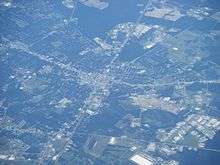
Located in the far southern portion of the state, near the Florida line along the Interstate 75 corridor, it is a commercial center of South Georgia with numerous manufacturing plants. The surrounding area produces tobacco, naval stores, particularly turpentine, as well as pine lumber, and pulpwood. According to the Georgia Department of Community Affairs, Valdosta is called the "Naval Stores Capital of the World" because it supplies 80% of the world demand for naval stores.[39][40]
In the retailing field, Valdosta has one major regional mall, Valdosta Mall, which features national chain anchor stores like JCPenney, Bed, Bath & Beyond, Buckle, PetSmart, Belk, Old Navy, and Ross Stores. Several large stores surround the mall or are near the mall including Best Buy, Home Depot, Kohl's, Lowe's, Office Max, Target, and Publix. Valdosta has other notable shopping areas such as the Historic Downtown area with many local businesses,[41] and the Five Points area which has a Big Lots, Winn-Dixie, and numerous national franchise and local restaurants.
Moody Air Force Base is located about 9 miles (14 km) north of Valdosta in northern Lowndes County.
Wild Adventures, a 166-acre theme and water park, is located 5 miles from Valdosta in rural Lowndes County. Wild Adventures is owned by Herschend Family Entertainment.
Education
Public schools

The Valdosta City School District holds grades pre-school to grade twelve, consisting of five elementary schools, two middle schools, and a high school. The school district serves the city of Valdosta and the surrounding communities of Lowndes County.[42] As of 2010 the district has 447 full-time teachers and over 7,178 students.[43]
The Lowndes County School District serves communities of Lowndes County outside of the Valdosta city limits.[44]
Scintilla Charter Academy is a free public school of choice open to any student who resides in Lowndes county or the city of Valdosta. SCA holds grades kindergarten to grade five.
Private schools
Valwood School is an independent college preparatory school enrolling students in Pre-Kindergarten through twelfth grade.[45] Several Christian Schools offering classes K-12 also operate in and near Valdosta including Georgia Christian School, Lighthouse Christian School, Open Bible Christian School, Highland Christian Academy, St. John Catholic School, and Victory Christian School.
Higher education
Valdosta is also the home of Valdosta State University[46] (VSU), founded in 1906 as South Georgia State Normal College for Women. It became part of the University System of Georgia in 1950 as Valdosta State College. Valdosta State College achieved university status and became VSU in 1993 and is one of two regional universities in Georgia. VSU has seen substantial growth in the past decade and currently has an enrollment of over 13,000 students. VSU is also the site of the Georgia Governor's Honors Program (GHP), a yearly four-week gathering of meritorious high school students in subjects ranging from standard academic subjects (i.e. math, languages, social studies, etc.) to broader intellectual enterprises (i.e. dance, theater, agricultural sciences.)
An extension of Georgia Military College[47] is in the city limits, and Wiregrass Georgia Technical College[48] is located a mile outside of the city limits off of Interstate 75.
Also located in Valdosta is Embry-Riddle Aeronautical University-Worldwide: Moody Campus.[49]
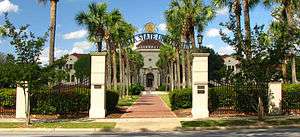

- Georgia Military College Valdosta Campus
Public libraries

The South Georgia Regional Library operates two libraries in Valdosta: Valdosta Lowndes County Library and Mae Wisenbaker McMullen Memorial Southside Library. Valdosta Lowndes County Library, with over 32,000 square feet (3,000 m2) of space, houses the administrative offices of the library system. Built for $450,000, it first opened in 1968.[50] The Mae Wisenbaker McMullen Memorial Southside Library opened on May 31, 1992. An area businessperson, J.C. McMullen, donated the land used for the Southside Library, which was built as part of a larger library construction program; it was named after Mae Wisenbaker McMullen, the mother of J.C. McMullen.[51]
The first library for African-Americans in Lowndes County began operations in the Walton Building on January 21, 1935, closed in February 1939, and reopened in 1955. In 1963 all libraries became available to patrons of all races.[51]
Museum
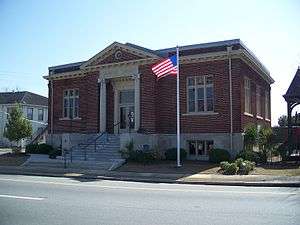
The Lowndes County Historical Society & Museum is located at the Carnegie Library of Valdosta, a National Register of Historic Places listed building and Carnegie library,[52] one of 24 Carnegie Libraries in Georgia.
LGBTQ Community
The South Georgia Pride Festival is held every third Saturday in September. This festival is for the LGBTQ Community and their allies in the Valdosta and surrounding counties. The first festival was held in 2008 on the front lawn of Valdosta State University, hosted by the VSU Gay Straight Alliance. It was called a day to celebrate diversity. In 2009 the festival became South Georgia Pride and held its festival at the John W Saunders Park in Valdosta in 2010. The Valdosta Mayor John J. Fretti proclaimed September 17, 2011 as South Georgia Pride Day.[53] In 2011 the organization became a 501c3 Non Profit. Since 2010 the festival has grown to over 3,000 people attending. The day is filled with music, entertainment, free HIV testing, and vendors. In July 2012 Mayor John Gayle refused to give a Proclamation to South Georgia Pride. Their Proclamation was the only one he has refused.[54][55]
Sports
Wakeboarding
Valdosta is famous for its notorious wakeboard facility Valdosta Wake Compound established 2012. It has since then grown to be the main action sport attraction in Georgia. The compound is home to international events such as the worlds biggest wakeboard event the Valdosta Yard Sale a WWA pro athlete event. It also hosts an annual grassroots music festival, Wake Up Fest.
High school football
Valdosta has a strong high school football tradition. The Valdosta High School Wildcats have one of the most successful high school football programs in the country with 913 wins, six national championships (1962, 1969, 1971, 1984, 1986, 1992), 24 Georgia state championships between 1920 and 2016, and 41 region titles.[56]
Cross-town rival Lowndes High School have also built a strong program, winning five state titles since 1980 (including 1999, 2004, 2005 and 2007).[57]
Local private school, Valwood School has won six GISA state football titles in Class A (1985, 1986, 1999), Class AA (2012) and Class AAA (2015, 2017).[58]
The annual matchup between the two public high schools, Lowndes and Valdosta High, is known as the Winnersville Classic.[59] Valdosta leads the overall series 34-16 and 19-12 since 1981 when the annual match was named the Winnersville Classic.
Valdosta State University
Football
The Valdosta State University Blazers have won a total of three Division II National Championship titles (2004, 2007 and 2012) and have also have won 6 Gulf South Conference football championships (1996, 2000, 2001, 2002, 2004, 2010).
Tennis
Valdosta State University's Men's Tennis team won the 2006 and 2011 NCAA Division II national championships.[60] The team has also appeared in the national title game in 2004, 2007, and 2010.
Valdosta State's Men's Tennis team leads the Gulf South Conference with nine conference championships (1996, 2000, 2001, 2004, 2007, 2008, 2009, 2010, 2011).[61] In 2011 the men's team became the first to win five consecutive GSC Championships in tennis.[62]
Baseball
The first baseball team at Valdosta State was formed in 1954 and had its first official season of intercollegiate competition in 1955. Tommy Thomas, became coach in 1967 and served as coach until 2007. Under Thomas, the Blazers saw 34 winning seasons, two conference titles, three Divisional titles, eight trips to the national tournament, and a Division II national championship in 1979. Thomas is the all-time wins leader in NCAA Division II baseball with 1302 wins. Greg Guilliams became VSU's head baseball coach in 2008 and won a Gulf South Conference East Division title in his first year and led Valdosta State to its first postseason appearance in seven years.[63]
In 1915 the Newark Peppers of the now defunct Federal League held spring training in Valdosta.[64]
Minor League Baseball
Valdosta hosted several different minor league baseball teams during the twentieth century, and was one of six cities in the Georgia State League which began play in 1906, with the team known as the Valdosta Stars.[65][66] From 1946-1958, the Valdosta Tigers were a "Class-D" minor league team. Valdosta was also home to the Valdosta Trojans which was a "farm" team for the Brooklyn Dodgers.
ESPN's Titletown, USA
TitleTown USA was a month-long segment on ESPN that started in the spring of 2008 and continued through July. Fans nominated towns and cities across the country based on their championship pedigree. A panel reviewed the nominees and fan voting in May determined the 20th finalist. SportsCenter visited each city in July, and fan voting July 23–27 determined the winner.
Due to the Valdosta High School football team's record as well as multiple championships in many sports by Valdosta State University, Lowndes High School, Valwood School, Georgia Christian School, and other academic institutions in the town, Valdosta was nominated as a finalist in 2008 for ESPN's "Titletown USA" contest. On July 28, 2008, with 29.2% of fan votes on ESPN's website poll, Valdosta was named TitleTown USA.[67]
Media
Newspaper
Radio
AM:
- WJEM 1150 AM; 5 kW Gospel
- WVLD 1450 AM; 1 kW Rock (Rock 106.9)
- WGUN 950 AM; 4 kW Adult Urban Contemporary
- WRFV 910 AM; 50 kW
FM:
- WDDQ TALK 92.1 FM Talk radio
- WAYT 88.1 FM Christian Contemporary (licensed to Thomasville)
- WVVS 90.9 FM VSU station
- WWET 91.7 FM
- WAAC 92.9 FM Country
- WJYF 95.3 FM Christian Contemporary
- WQPW 95.7 FM Adult Contemporary
- WJEM 96.1 (repeater of 1150 AM)
- WGOV-FM 96.7 FM Urban
- WAFT 101.1 FM Christian
- WXHT 102.7 FM Pop Hits (Broadcast from Valdosta but licensed to Madison, Florida)
- WSTI 105.3 FM Classic Soul and R&B (Broadcast from Valdosta but licensed to Quitman)
W295AO 106.9 Rock (repeater of 1450AM
- WWRQ 107.9 FM The Beat
Television
Valdosta and Lowndes County is part of the Tallahassee, Florida television market and receives most channels from that city; it also receives some channels from the neighboring Albany market. See Template:Tallahassee TV and Template:Albany GA TV.
- WSWG channel 44 is the local CBS affiliate licensed to Valdosta and based in Moultrie, programmed by WCTV in Tallahassee. The station serves the Valdosta and Albany areas, and includes subchannels offering programming from MyNetworkTV, Me-TV and The CW.
- WXGA-TV channel 8 is the local GPB outlet, licensed to Waycross.
Notable people
Entertainment
Sports
Politics
|
Valdosta in fiction
- Parts of Fannie Flagg's novel Fried Green Tomatoes at the Whistle Stop Cafe and the 1991 film based upon the novel are set in Valdosta.
- In Allen Steele's science fiction novel Coyote Frontier, Valdosta in the year 2070 is the site of Camp Buchanan, an internment camp for dissident liberal intellectuals.
- Scenes from Ernest in the Army take place in Valdosta, even though the entire film was shot in South Africa.
- Scenes from the film Zombieland, starring Woody Harrelson, were shot on Valdosta streets and at nearby Wild Adventures theme park.[72]
- In Cotton Patch Gospel, Joe moves Jesus and the rest of the family to Valdosta when Herod dies.
- The Lady Chablis performed in Valdosta in the novel Midnight in the Garden of Good and Evil by John Berendt.
- The 1986 movie As Summers Die starring Bette Davis and Jamie Lee Curtis was filmed in Valdosta.
- In John Steinbeck's novel East of Eden, Adam Trask stops in Valdosta to steal supplies and request money from his brother Charles after escaping from a Florida chain gang on his way back to Connecticut.
See also
References
- ↑ "City of Valdosta Website". City of Valdosta Website. Retrieved September 5, 2012.
- 1 2 "Population and Housing Unit Estimates". Retrieved June 9, 2017.
- 1 2 3 "American FactFinder". United States Census Bureau. Retrieved 2008-01-31.
- ↑ "US Board on Geographic Names". United States Geological Survey. 2007-10-25. Retrieved 2008-01-31.
- 1 2 "Valdosta (city) QuickFacts from the US Census Bureau". Quickfacts.census.gov. Archived from the original on January 13, 2014. Retrieved January 13, 2014.
- ↑ "American FactFinder". Factfinder2.census.gov. 2010-10-05. Retrieved September 6, 2012.
- ↑ "American FactFinder". Factfinder2.census.gov. 2010-10-05. Retrieved September 6, 2012.
- ↑ "VALDOSTA STATE UNIVERSITY OFFICE OF INSTITUTIONAL RESEARCH ENROLLMENT UPDATE : Spring 2015" (PDF). Valdosta.edu. Retrieved 2017-08-27.
- ↑ National High School Sports Record Book Archived March 17, 2009, at the Wayback Machine.
- ↑ "Valdosta | Georgia.gov". Valdosta.georgia.gov. Retrieved September 6, 2012.
- ↑ "Valdosta Georgia". History. Retrieved September 6, 2012.
- ↑ Poling, Dean (October 12, 2009). "What does Valdosta mean?". The Valdosta Daily Times. Archived from the original on July 19, 2012. Retrieved November 4, 2011.
- ↑ Eric Dewayne Jackson (2003). "Lowndes County Georgia List of Emigrants to Arithington, Liberia". Retrieved 8 January 2008.
- ↑ "Lowndes County During Reconstruction - Valdosta State University". Valdosta.edu. Retrieved August 27, 2017.
- ↑ Jessica Pope (2007-09-29). "A trip through time". The Valdosta Daily Times. Archived from the original on 2013-02-05. Retrieved January 1, 2008.
- ↑ Billy Bruce (2007-12-22). "Breathing fresh life into Downtown". The Valdosta Daily Times. Archived from the original on 2013-02-09. Retrieved January 1, 2008.
- ↑ "Lowndes County Courthouse". valdostamuseum.com. Retrieved 13 April 2017.
- ↑ "Gypsy". The New Georgia Encyclopedia. Retrieved December 31, 2007.
- ↑ "Elephant Kills Keeper" (PDF). The New York Times. 1902-11-24. Retrieved January 13, 2014.
- ↑ "Valdosta's Bars Are Now Closed". Atlanta Constitution. Atlanta, Georgia. 29 July 1907.
- ↑ "Triple Crown Hometowns". Archived from the original on 2007-10-21. Retrieved January 8, 2008.
- 1 2 3 4 5 Meyers, Christopher C (2006). "" Killing Them by the Wholesale": A Lynching Rampage in South Georgia". The Georgia Historical Quarterly. JSTOR. 90 (2): 214–235. Retrieved 14 May 2013.
- ↑ "Remembering Mary Turner". Maryturner.org. 1918-07-10. Retrieved 2016-07-13.
- ↑ Flaisig, Liz (October 2, 2007). "Wild Adventures theme park is sold, but fun will continue". The Florida Times-Union. Archived from the original on April 13, 2017. Retrieved April 13, 2017.
- ↑ Teresa L. Morisi (August 1996). "Commercial banking transformed by computer technology" (PDF). Monthly Labor Review. Archived from the original (PDF) on 2011-10-22. Retrieved January 13, 2014.
- ↑ Kirkpatrick, Rob (2009). 1969: The Year Everything Changed. Skyhorse Publishing Inc. p. 266. ISBN 9781602393660.
- ↑ Ron Starner (March 2004). "The Road to Boomtown". Site Selection. Retrieved January 13, 2014.
- ↑ "#79 Valdosta GA". Forbes. 2010-04-14. Archived from the original on 2010-04-20. Retrieved January 13, 2014.
- ↑ "US Gazetteer files: 2010, 2000, and 1990". United States Census Bureau. 2011-02-12. Retrieved 2011-04-23.
- ↑ CNN Staff. "Family demands coroner's inquest in teen's gym mat death", CNN. October 22, 2013. Retrieved on October 22, 2013.
- ↑ "Valdosta, Georgia Köppen Climate Classification (Weatherbase)". Weatherbase. Retrieved August 27, 2017.
- ↑ First and Last Frost Dates in Georgia 1997-2007 University of Georgia College of Agricultural and Environmental Sciences
- ↑ "The Weather Channel: Monthly Avearges". The Weather Channel. Archived from the original on October 22, 2012. Retrieved July 27, 2010.
- ↑ "Historical Weather for Valdosta, Georgia, United States". Weatherbase. Retrieved 2010-07-27.
- ↑ Lowndes County Historical Society and Museum
- ↑ "Census of Population and Housing". Census.gov. Retrieved June 4, 2015.
- ↑ "American FactFinder". Factfinder.census.gov. Retrieved September 6, 2012.
- ↑ "American FactFinder". Factfinder2.census.gov. 2010-10-05. Retrieved September 6, 2012.
- ↑ "Georgia Department of Community Affairs' Data for Valdosta". Retrieved July 28, 2008.
- ↑ ""Faces in the Piney Woods": A History of Turpentine, Valdosta State Archives and Special Collections". Retrieved December 12, 2014.
- ↑ "Downtown Valdosta, GA". Valdosta Main Street. Retrieved September 6, 2012.
- ↑ Georgia Board of Education, Retrieved June 23, 2010.
- ↑ School Stats, Retrieved June 23, 2010.
- ↑ Georgia Board of Education, Retrieved June 23, 2010.
- ↑ "Valwood School - About Valwood". Valwood.org. Archived from the original on August 30, 2012. Retrieved September 6, 2012.
- ↑ Valdosta State University, Retrieved June 23, 2010.
- ↑ Georgia Military College- Valdosta Campus Archived May 22, 2010, at the Wayback Machine., Retrieved June 23, 2010.
- ↑ Valdosta Technical College Archived June 15, 2010, at the Wayback Machine.. Retrieved June 23, 2010.
- ↑ "Embry-Riddle Worldwide". Archived from the original on November 10, 2011. Retrieved January 13, 2014.
- ↑ "Valdosta Lowndes County Library." South Georgia Regional Library. Retrieved on May 14, 2017.
- 1 2 "McMullen Southside Library ." South Georgia Regional Library. Retrieved on May 14, 2017.
- ↑ "Valdosta Museum and Lowndes County Historical Society". Valdostamuseum.org. Retrieved September 6, 2012.
- ↑ "Valdosta Mayor Proclaims Sept 17 as "South Georgia Pride Day"". Georgia Voice. September 16, 2011.
- ↑ "Valdosta mayor refuses to sign South Georgia Pride proclamation". Georgia Voice. July 25, 2012.
- ↑ "Pride denied: Valdosta mayor denies LGBT event proclamation". Valdosta Daily Times. July 27, 2012.
- ↑ Archived November 7, 2011, at the Wayback Machine.
- ↑ "Lowndes Football History". Lowndesfootball.com. Archived from the original on June 7, 2012. Retrieved September 6, 2012.
- ↑ "GISA Stats Your Source for GISA Sports". Gisastats.com. Archived from the original on March 15, 2013. Retrieved September 6, 2012.
- ↑ "The History of the Winnersville Classic » Local Sports". Valdosta Daily Times. Retrieved September 6, 2012.
- ↑ "NCAA Division II Men's Tennis Championship Bracket". NCAA.com. Archived from the original on June 16, 2012. Retrieved September 6, 2012.
- ↑ "Gsc Men's Tennis Championship Team" (PDF). Archived from the original (PDF) on September 27, 2011. Retrieved September 6, 2012.
- ↑ "Valdosta State - Blazers Claim Fifth Consecutive GSC Championship". Vstateblazers.com. Retrieved September 6, 2012.
- ↑ Archived February 26, 2012, at the Wayback Machine.
- ↑ The ESPN Baseball Encyclopedia. Sterling Publishing. 2007. p. 1789. ISBN 1-4027-4771-3.
- ↑ "New Georgia Encyclopedia: Minor League Baseball". Georgiaencyclopedia.org. 2005-03-17. Retrieved September 6, 2012.
- ↑ "Valdosta, Georgia Minor League History". Baseball-Reference.com. Retrieved September 6, 2012.
- ↑ "ESPN names Valdosta TitleTown USA". Archived from the original on 2008-08-01. Retrieved January 13, 2014.
- ↑ "Tuskegee Airmen". CommunityWalk. Retrieved September 6, 2012.
- ↑ "We Are Marshall (2006)". IMDb.com. Retrieved August 27, 2017.
- ↑ "Marshall University - Huntington, WV". Marshall.edu. Retrieved September 6, 2012.
- ↑ "Stan Rome NFL Football Statistics". Pro-Football-Reference.com. 1956-06-04. Retrieved September 6, 2012.
- ↑ Dean Poling (February 26, 2009). "Zombieland: Psst! There's a movie in town". Valdosta Daily Times. Archived from the original on June 30, 2012. Retrieved March 5, 2009.
External links
| Wikimedia Commons has media related to Valdosta, Georgia. |
| Look up Valdosta in Wiktionary, the free dictionary. |
| Wikivoyage has a travel guide for Valdosta. |
- Valdosta New Georgia Encyclopedia
- City of Valdosta Website Portal style website, Government, Business, Library, Recreation and more
- City-Data.com Comprehensive Statistical Data and more about Valdosta
- South Georgia Historic Newspapers Archive Digital Library of Georgia

